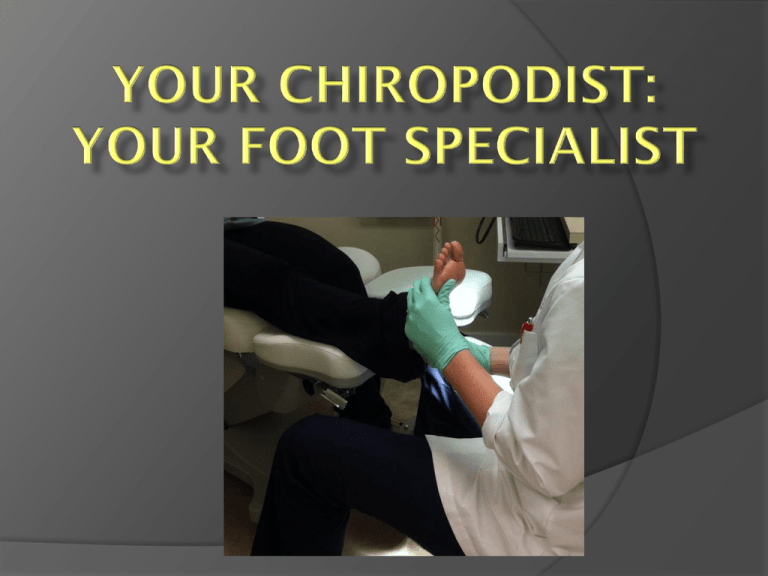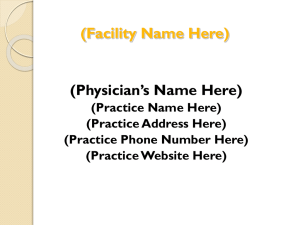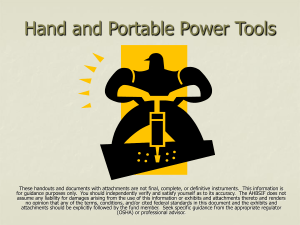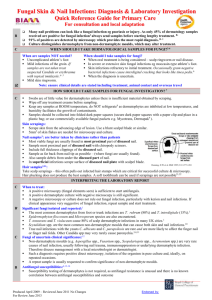View the presentation... - The Kingston Foot and Ankle Clinic
advertisement

The field of Podiatry specializes in the following areas: Assessment of forefoot and rearfoot abnormalities. Gait abnormalities Balance problems Leg length discrepancy Disorders that interfere with proper walking and sports function Assessment and prescription to reduce abnormality and restore function- eliminate pain Joint pain Soft tissue injury Plantar fasciitis Achilles tendonitis Bunions Shin splints Forefoot pain Finally a cure to a stubborn but common nail infection Early identification Effective treatments Conservative treatments Surgical treatments for conditions such as ingrown toenails Cause identification Immediate relief with treatment Venous insufficiency Treatment with compression stockings Testing for neuropathy Testing for poor circulation Diabetes education Routine nail care and callus debridement Effective elimination of all types of these viral infections. Plantar warts are a common skin affliction that presents in podiatry offices Plantar warts are caused by the human papilloma virus (HPV) types 1, 2, 4 and 63. This virus is contagious. Common areas to pick up plantar warts on the feet include: -Change rooms -Indoor pool areas -Public Showers There are several treatment options available to eliminate warts One common wart treatment in the office is removing the thick skin on top and using topical treatments that may contain salicylic acid Other wart treatments include: Laser treatment Liquid nitrogen Surgical removal Prescriptions for home application Most treatments require more than one visit to the office depending on the wart's size, type, location and how long it has been there. There may be some discomfort associated with treatment Over-The-Counter Wart Treatments There are many over-the-counter wart treatments available that could be helpful for new, small or lessresistant warts Some types of plantar warts in children may disappear on their own without any treatment, while others can multiply and need professional treatment How To Avoid Picking Up A Plantar Wart Wear footwear around pool decks Wear swim shoes or sandals in public showers It is best to seek advice from your foot specialist to determine which type of wart you have and discuss the best options for treatment If you discover an unknown lesion on your foot, it is best to cover it with tape to prevent crosscontamination, until you have it looked at by your foot specialist Foot orthotic therapy involves using an appliance that fits inside your shoe to eliminate abnormal pressure and pain Types of Foot Orthotics: Over-the-counter True custom made orthotics Accommodative orthotics All types are made to relieve the pain of a foot issue or correct an abnormality Only chiropodists/podiatrists have completed the appropriate training to assess the patient's needs and prescribe the appliance that will work the best for each individual Your practitioner must first complete a full biomechanical assessment to determine if an orthotic appliance is right for you and your condition Gait Analysis In many cases, your gait (the way you walk) will be assessed to determine if you have an imbalance between your right leg and your left leg. Custom made orthotics are made from a non-weight bearing plaster cast or 3-D computerized image of the feet There are two types of foot orthotics that are prescribed: Corrective orthotics try to correct or reduce an abnormality Accommodative orthotics support the foot and deflect from a painful area This is why your Chiropodist's prescription is essential There are many different materials used in orthotic therapy ranging from very soft to very rigid, and this depends on your needs Many people opt to treat foot, knee, hip and back pain with orthotic therapy because it addresses the root of the problem, trying to eliminate the need for pain-killing medication or surgery Effective elimination of fungal infections on toenails. Fungal Nails (Onychomycosis) The prevalence of onychomycosis is about 6-8% in the adult population. Affects approximately one-third of diabetics. 56% more frequent in people suffering from psoriasis. Signs and Symptoms of a Fungal Nail Infection Thickened nails Discoloured nailswhite, black, yellow or green Brittle nails Nail lifting off the toe Pain underneath or around the nail Risk Factors for Fungal Infections Wearing socks or shoes that hinder ventilation Walking barefoot in swimming pools, gyms or change rooms. Excessive sweating Minor skin or nail injury Weakened immune system Treatment of Nail Fungus TOPICAL ANTIFUNGALS Treatment of Nail Fungus ORAL ANTIFUNGALS When topical antifungals fail to treat nail fungus, oral Lamisil is sometimes prescribed. Oral lamisil has been associated with cases of liver failure and many other side effects making it a last resort treatment option. Treatment of Nail Fungus NAIL FUNGUS LASER TREATMENT Finally a cure to a stubborn but common nail infection. Nail Fungus Laser Treatment The Q-Clear™ Laser System is approved by the FDA and is proven to be an effective treatment for patients with fungal nails Nail Fungus Laser Treatment Mild cases will typically respond to a single treatment Moderate to severe cases may need debridement and more than one treatment. The treatment is painless and takes less than one minute per nail. Nail Fungus Laser Treatment How to Prevent Nail Fungus Do not share nail clippers, files, shoes or socks with others. Try not to injure your nail, such as by cutting it too short (trauma to the nail may lead to infections). Wear shower sandals or shower shoes when you are at a public pool or shower. Wear dry cotton socks and change them two or three times a day if necessary.







